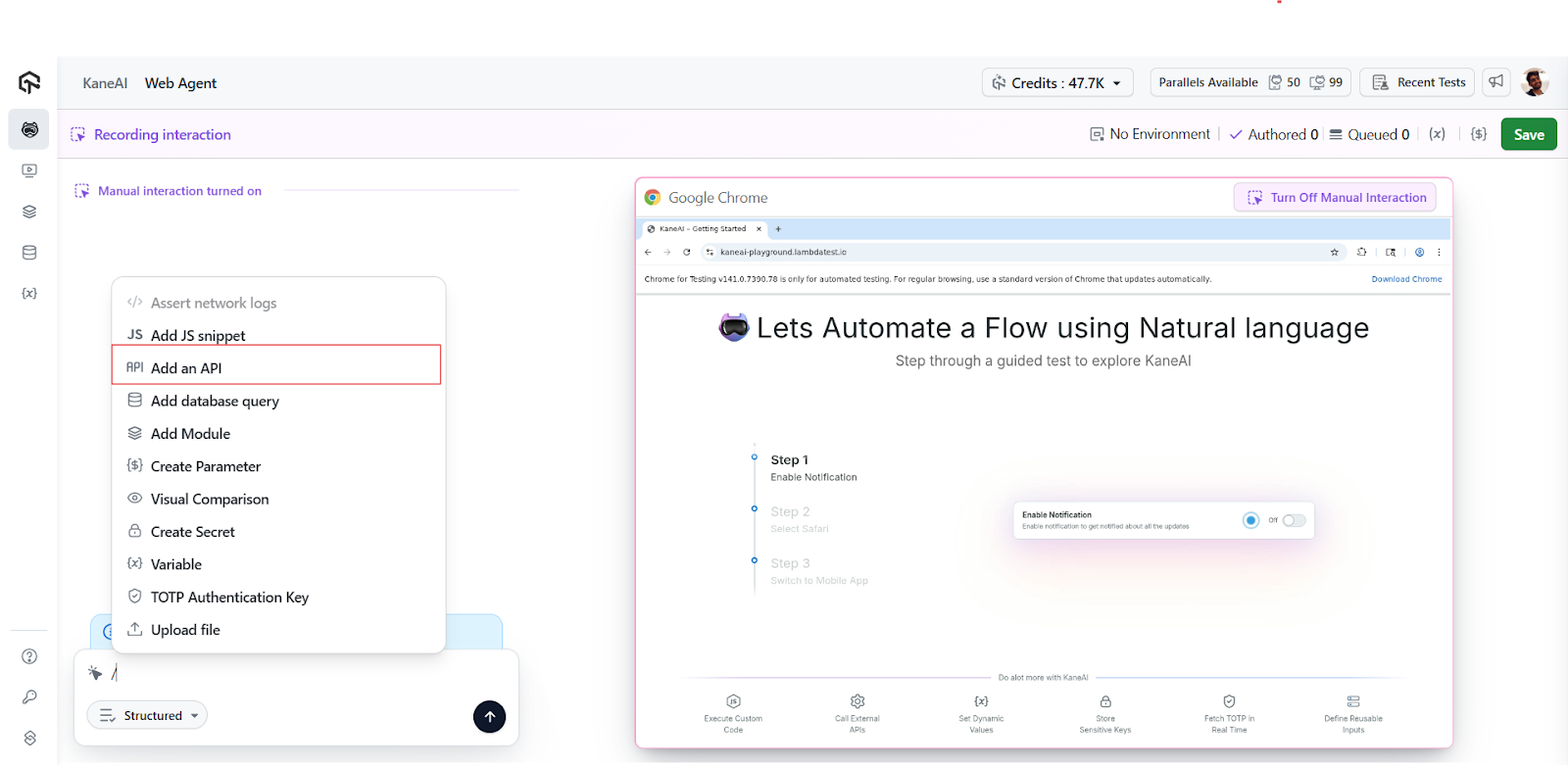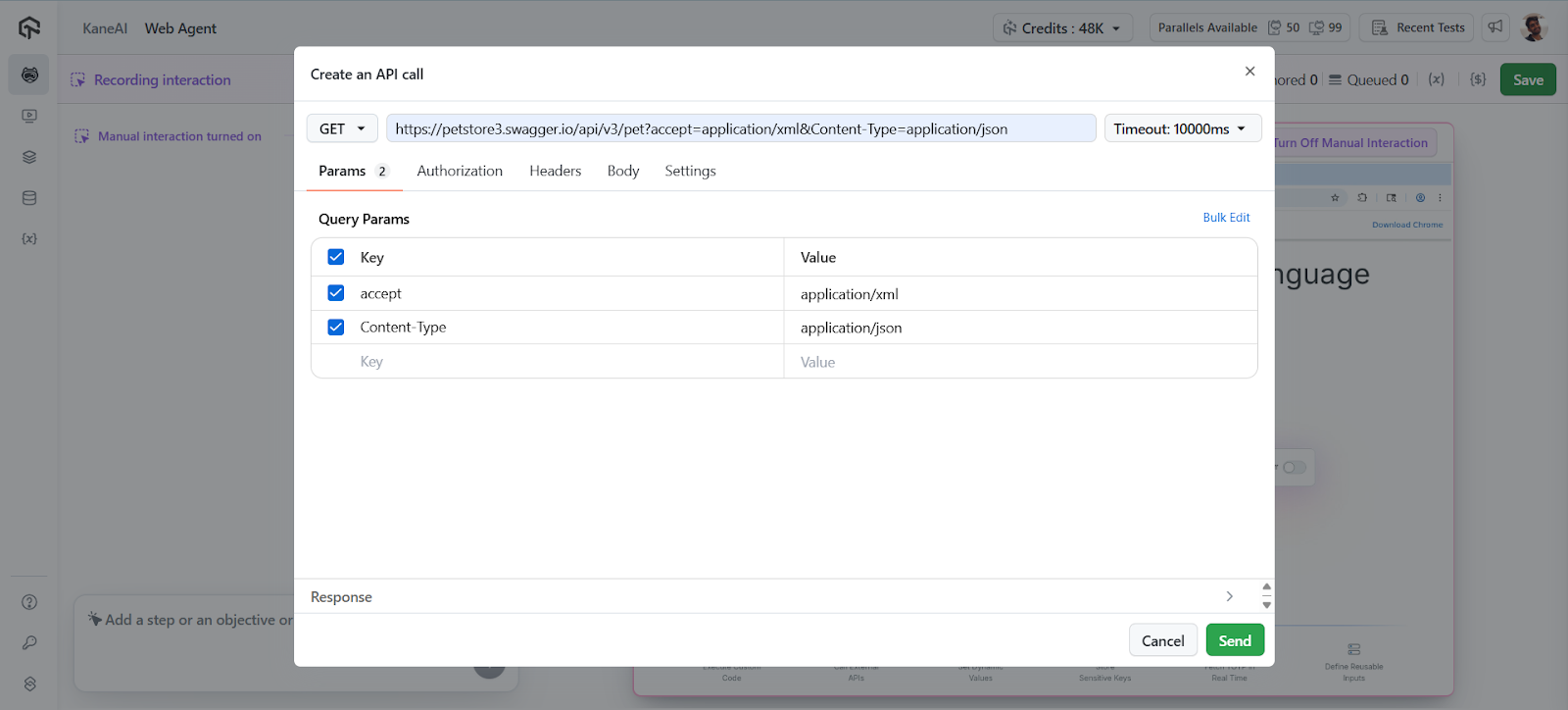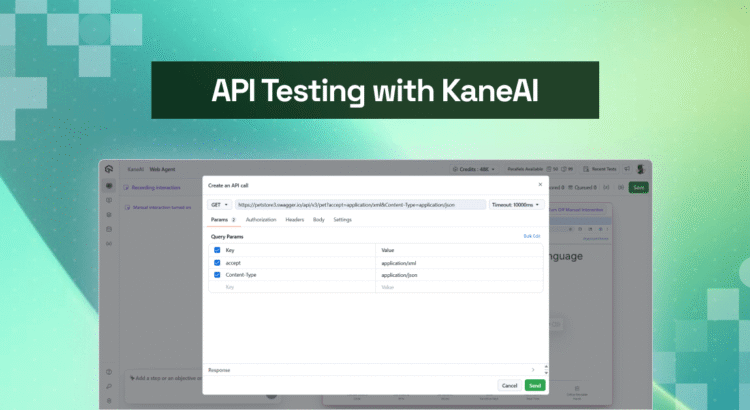Modern applications rely heavily on APIs to connect services, manage data flows, and enable seamless user experiences. However, traditional testing approaches often treat API and UI testing as separate processes, resulting in:
- Fragmented testing workflows requiring multiple tools and platforms
- Delayed feedback loop when backend issues are not caught early
- Incomplete test coverage that misses important API-UI interactions
- Resource inefficiencies of managing separate test environments
KaneAI’s LambdaTest bridges this gap by offering seamless API testing capabilities along with powerful UI testing features, thereby providing a unified testing platform for development teams.
Integrated API Testing with KaneAI
KaneAI’s LambdaTest addresses this challenge by integrating API testing directly into your existing testing workflow. This integrated approach allows teams to validate frontend functionality and backend services in one platform, simplifying the entire testing process.
See detailed support documentation to get started with API testing using KaneAI.
What are the Benefits of API testing?
API testing offers significant advantages in terms of efficiency, system security, and overall product quality. Here are some of the key benefits of incorporating API testing into your development workflow:
- Faster Release: While GUI testing is time consuming, API testing speeds up the process, saving up to eight hours of testing time. This allows your team to focus on other important aspects of software development and increases your overall product release speed.
- Enhanced Test Coverage: API testing goes deeper than just the user interface by validating core system components, such as database interactions. By testing APIs, you ensure that all layers of your application function properly, resulting in better coverage and, ultimately, higher quality software and more satisfied users.
- Shift-Left Testing Made Easy: API testing can be implemented early in the development cycle without requiring a GUI. Developers can quickly run tests, get real-time feedback, and resolve issues at an early stage. Compared to UI testing, API testing is typically completed in seconds or minutes, offering faster insight into system performance.
- Minimal Maintenance: Because changes to the API layer occur infrequently and are usually associated with major updates in business logic, API testing requires less ongoing maintenance. By reflecting your desired API specifications from the start, you can ensure your system remains stable, even as updates are made.
- Faster Bug Detection and Resolution: With the speed of API testing, bugs are detected and diagnosed earlier in the development process. Immediate feedback means faster bug fixes, preventing delays, and increasing the overall efficiency of your development cycle.
- Lower Testing Costs: The comprehensive nature of API testing, as well as faster execution and easier maintenance, significantly reduces overall testing costs. This allows you to reallocate resources to other high priority areas, thereby increasing ROI.
- Cross Language Compatibility: API testing supports data exchange in XML and JSON formats, meaning you can use a variety of programming languages, including JavaScript, Java, Ruby, Python, or PHP. This flexibility ensures your team can test APIs using the tools and languages they are most comfortable with.
By incorporating API testing into your workflow, especially with advanced tools like KaneAI, you can achieve faster, more efficient, and cost-effective testing, while ensuring safer, higher-quality products.
API testing demo with Real World Use Cases:
Let’s explore how development teams can leverage KaneAI’s API testing capabilities using practical e-commerce scenarios. We will use the PetStore API as an example to demonstrate comprehensive backend testing.
Setting Up Your API Testing Environment
Initialized API Testing by creating web tests and adding APIs via KaneAI’s intuitive slash command interface.

Fast API configuration with cURL commands helps automatically configure API settings by simply pasting your cURL commands into the designated area, where KaneAI intelligently fills in all the necessary details, including headers, parameters, and request body, eliminating manual configuration errors and significantly speeding up test setup.

Validating API Responses for Reliability
KaneAI’s validation feature ensures your API responds correctly before including it in your test suite.
When you click ‘validate’, the system will check the API response and automatically add successful requests (which return status 200) to your test step. This automatic validation prevents incorrect APIs from entering your test pipeline.
Handling Edge Cases and Error Scenarios
Real-world testing isn’t just about the happy path. KaneAI allows you to manually add APIs that return non-200 status codes, such as a 400 Bad Request response. This capability is critical for testing error handling, validation logic, and edge cases that your application must manage well. negative testing/negative workflow
Simplify Testing with Batch Processing
For complex applications with multiple API endpoints, KaneAI offers batch processing capabilities. You can add multiple APIs simultaneously by clicking the plus icon and selecting each endpoint, or pasting multiple cURL commands for automatic addition. This feature is especially valuable when testing integrated workflows that involve multiple service calls.
Modern APIs use various HTTP methods for different operations. KaneAI supports the full spectrum of HTTP methods including POST for creating resources, PUT for updates, GET for retrieval, and DELETE for deletion. This comprehensive support ensures you can test complete CRUD operations and complex API interactions.
How to get Execution and Performance Insights on API Testing?
Once your API test suite is configured, KaneAI enables simultaneous execution of all added APIs. This parallel execution approach provides immediate insight into API performance, response times, and data integrity across your backend infrastructure.
Execution results include detailed information about:
- The HTTP method is used for each request
- Response status codes and their meanings
- Execution time for performance analysis
- Response data for validation and debugging
 Notes
NotesStart your API Testing with KaneAI. Get Started Now!
Best Practices for API Testing
API testing involves several best practices, including structuring your tests logically, leveraging validation tools, testing beyond success scenarios, and monitoring performance metrics. These practices help make your API testing more efficient, reliable, and robust.
Structure Your Tests Logically
Organize your API tests to reflect your application workflow. Group related API calls and ensure your test sequence matches actual user interactions.
Leverage Validation Feature
Always validate API responses before adding them to your test steps. This practice ensures your test suite remains reliable and catches regressions effectively.
Test Beyond Success Scenarios
Include error cases and edge conditions in your test suite. Testing how your API handles invalid input and error states is critical to building resilient applications.
Monitor Performance Metrics
Use KaneAI execution time data to establish performance baselines and identify potential bottlenecks in your API infrastructure.
All in All!
KaneAI’s LambdaTest API testing capabilities represent a significant advancement in a comprehensive testing strategy. By providing a unified platform for UI and API testing, KaneAI enables development teams to build more reliable applications while optimizing their testing workflows.
The integration of API testing into existing test suites, combined with features such as auto-configuration, batch processing, and comprehensive HTTP method support, makes KaneAI an invaluable tool for modern development teams.
Happy Testing!
News
Berita
News Flash
Blog
Technology
Sports
Sport
Football
Tips
Finance
Berita Terkini
Berita Terbaru
Berita Kekinian
News
Berita Terkini
Olahraga
Pasang Internet Myrepublic
Jasa Import China
Jasa Import Door to Door
